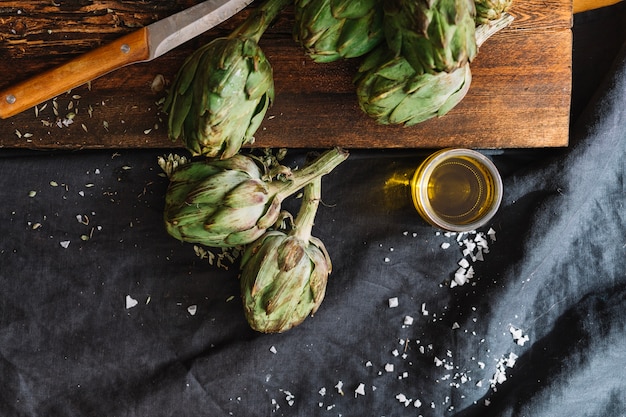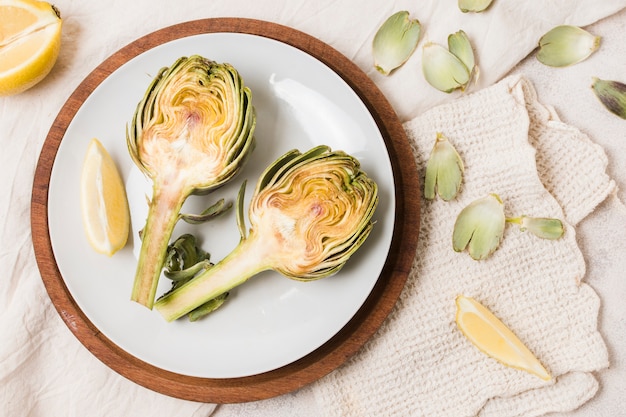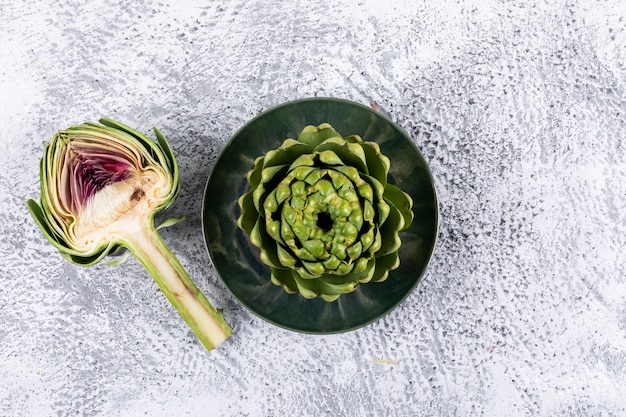Part 1: Getting Started - Choosing and Preparing Your Artichokes

Choosing the Perfect Artichokes
First impressions matter, even with artichokes. When you're browsing the market, look for artichokes that are plump and tightly closed, almost like a little green ball. The leaves should be vibrant green, free of any brown spots or wilting. A good artichoke should feel heavy for its size, indicating it's packed with flavour. Think of it this way: you're picking the stars of your culinary show, so go for the best!A Gentle Cleaning Ritual
Okay, now comes the cleaning part. You might need to wash your hands a bit more than usual, but don't fret, it's a manageable process.Here's how I clean my artichokes:
- Trim the stem: Grab a sharp knife and trim the stem about an inch above the base. I usually cut it at an angle, which makes it easier to stand upright later.
- Remove the tough outer leaves: The outer leaves are a bit too tough, so we need to give them the boot. Gently peel them away, and you'll be left with about 10-12 layers of leaves that will be perfect for eating.
- Tackling the choke: Now, for the fuzzy, inedible part – the choke. This is at the centre of the artichoke. Use a spoon to scrape out the choke, getting rid of as much as you can. If you want, you can trim it back with a knife for a more thorough clean.
- A good rinse: Rinse the artichokes under cold running water to wash away any lingering dirt or debris. This will help keep them fresh and crisp.
Part 2: Boiling Time – A Symphony of Flavor

The Right Pot for the Job
Let's get the boiling party started! A large pot with a tight-fitting lid is ideal. Don't be shy, go big! Your artichokes need room to cook evenly.Adding the Magic Ingredients
We're going to create a flavourful broth that will infuse those artichokes with a delightful taste. We need water, lemon juice, and a touch of salt. The lemon juice prevents browning and keeps those artichokes looking fresh. The salt? It enhances their natural sweetness.Here's how I usually do it:
- Fill the pot: Fill the pot about two-thirds full with water.
- A squeeze of lemon: Add the juice of one lemon.
- A pinch of salt: Add about 2 tablespoons of salt. Feel free to adjust the salt to your taste, but remember, a little goes a long way.
Submerging and Simmering
Now, gently place those cleaned artichokes into the boiling water, making sure they're fully submerged. Bring the water back to a boil, then reduce the heat to a gentle simmer. This is the crucial part, the slow and steady cooking that will create those tender hearts.The cooking time is like a dance between size and preference. It depends on the size of your artichokes and how tender you like them. Here's a general guideline:
| Artichoke Size | Boiling Time |
|---|---|
| Small | 20-25 minutes |
| Medium | 25-35 minutes |
| Large | 35-45 minutes |
Part 3: Checking for Doneness - The Art of the Pull Test

Part 4: Cooling and Serving – The Culinary Finale
Once those artichoke hearts are cooked, drain them in a colander and let them cool slightly. It's fine to let them cool completely, they'll be easier to handle.Serving Up the Goodness
Now for the exciting part! It's time to savor those tender artichoke hearts. Here are a few of my favourite ways to enjoy them:- Dip and Devour: Dip those artichoke hearts into your favourite dip, like aioli, mayonnaise, or even a simple olive oil and vinegar dressing. You can even get creative and invent your own dipping sauce!
- Salad Star: Slice the artichoke hearts into thin slices and add them to a salad. They'll bring a delightful crunch and earthy flavour to your greens.
- Roasted Delight: Roast those artichoke hearts with garlic, herbs, and lemon juice for a simple and delicious side dish. Or, add them to a casserole or pasta bake for a flavour boost.
- Stuffed Sensation: Use the cooked artichoke hearts as a base for a stuffed dish. Fill them with a mixture of breadcrumbs, herbs, cheese, and other ingredients for a flavourful appetizer or side dish.
Part 5: Storing Leftovers - Keeping the Flavor Fresh
If you have leftover cooked artichokes, you can store them in the refrigerator for up to 3 days. Place them in an airtight container and they'll stay fresh and delicious!Part 6: Getting Creative – Expanding Your Culinary Horizons
One of the things I love most about artichokes is their versatility. They can be used in so many dishes, from simple salads to elaborate main courses. Here are a few ideas to get your creative juices flowing:- artichoke pizza: Top your favourite pizza dough with artichoke hearts, mozzarella cheese, and your favourite toppings for a delicious and unique pizza.
- artichoke dip: Combine cooked artichoke hearts with cream cheese, Parmesan cheese, garlic, and herbs for a classic and crowd-pleasing appetizer.
- artichoke pasta: Add cooked artichoke hearts to your favourite pasta dish for an extra burst of flavour and texture. They work especially well with creamy sauces or pesto.
Part 7: Tips and Tricks – Mastering the Art
Here are a few tips and tricks I've picked up over the years that might help you achieve artichoke perfection:- Don't overcook: Overcooked artichokes become mushy and lose their flavour. Keep a close eye on them and remove them from the pot as soon as they're tender.
- Use a steamer: If you prefer, you can steam artichokes instead of boiling them. This method helps to preserve the artichokes' natural flavour and texture.
- Don't throw away the leaves: While the heart is the most prized part of the artichoke, the leaves are still edible. Use a fork to scrape the soft, tender part of the leaves and enjoy their unique flavour.
- Get creative with seasoning: Experiment with different herbs and spices to add flavour to your boiled artichokes. A sprinkle of rosemary, thyme, or oregano can really elevate the taste.
Part 8: FAQs – Your Artichokes Questions Answered
1. How do I know if an artichoke is fresh?
A fresh artichoke will be firm and tightly closed, with vibrant green leaves and no signs of brown spots or wilting. It should also feel heavy for its size.2. Can I freeze cooked artichoke hearts?
Yes, you can freeze cooked artichoke hearts for up to 3 months. Simply place them in an airtight container or freezer bag and freeze until ready to use.3. How do I make artichoke dip?
To make a classic artichoke dip, simply combine cooked artichoke hearts with cream cheese, Parmesan cheese, garlic, and herbs. You can also add other ingredients, such as mayonnaise, sour cream, or jalapeno peppers, to create your own unique twist.4. What are some good dipping sauces for artichoke hearts?
Artichoke hearts go well with a variety of dipping sauces, such as aioli, mayonnaise, olive oil and vinegar dressing, pesto, or even a simple sprinkle of salt and pepper.5. What is the best way to eat artichoke hearts?
There's no right or wrong way to eat artichoke hearts. You can enjoy them dipped in a sauce, added to salads, roasted, stuffed, or used in a variety of other dishes. I hope this guide has helped you master the art of boiling artichokes. Now go forth and enjoy those delicious, tender artichoke hearts!Everyone is watching

Corn on the Cob: The Ultimate Guide to Perfectly Cooked Ears
Healthy MealsAh, corn on the cob. Just the name evokes images of sunny days, barbecues, and that sweet, juicy flavour that ...

Perfect Pork Roast Oven Cooking Time: A Guide to Delicious Results
Healthy MealsThere's something truly satisfying about a perfectly roasted pork. The aroma alone is enough to make your mout...

Ham Cooking Time: How Long to Bake, Smoke, or Boil a Delicious Ham
Healthy MealsAh, ham. It's a classic, isn't it? A real crowd-pleaser, especially around holidays. And when done right, it'...

Scallops: The Ultimate Guide to Perfect Cooking
Healthy MealsAh, scallops. Those delicate, sweet, and utterly delicious morsels of the sea. They hold a special place in my...

Spaghetti Squash: The Ultimate Guide to Cooking and Serving
Healthy MealsRemember that time you saw spaghetti squash at the supermarket, looking all bumpy and strange, and thought, "W...
